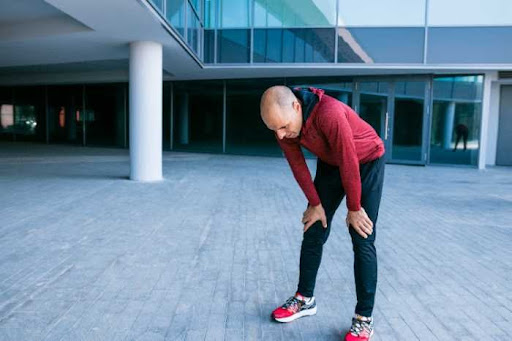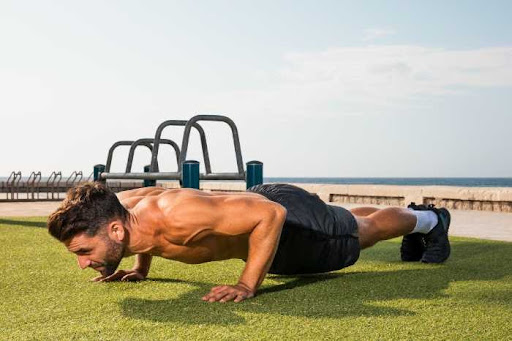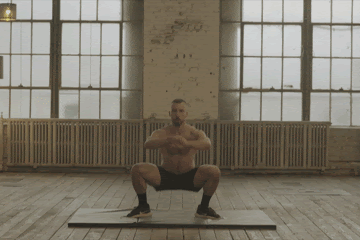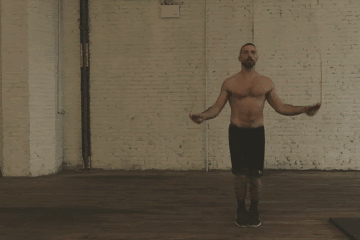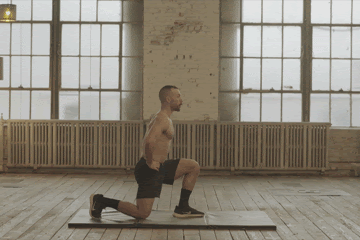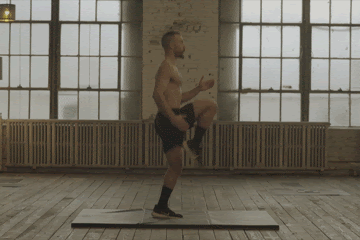In today’s hectic world, many people are looking for a way to manage their health without feeling like they have to invest hours at the gym every day.
This is where HIIT workouts come in! These 20-minute sessions can be done anywhere and are designed specifically to burn fat while improving your cardiovascular endurance. This article will look at what these workouts are and how you can get started with one of your own!
This article will guide you through a 20-minute bodyweight HIIT workout. The workout is designed for all fitness levels, so it’s perfect if you’re just starting out or are in need of a workout that will push you to your limit.
We’ll be using your own body weight (no equipment required) to get the heart rate up and burn calories!
What is High-Intensity Interval Training?
High-intensity Interval Training or most commonly known as HIIT is an exercise technique developed earlier in the 1970s but was heavily popularized by a Japanese researcher, Dr. Tabata, in 1996. Originally designed to improve athletic performance, it was soon marketed as an excellent method for weight loss. But this isn’t just a pure marketing sham. It’s backed up by research as well.
The protocol is introduced by a series of alternating a period of high-intensity exercise followed by active rest, then repeating this sequence for a few rounds.
For the exercise, the aim is to do as many reps as possible within the given time frame, while during rest, you still need to keep on moving to maintain a high heart rate.
Bodyweight exercises seem to be the best option when implementing a HIIT workout so that exercise intensity can’t easily be abused, defeating the protocol’s purpose.
Work-rest ratio
Let’s talk about the critical segment of HIIT that dictates the difficulty of your workout, hence making the difference in results.
Find the proper work-rest ratio that suits your skill level. The basic format follows.
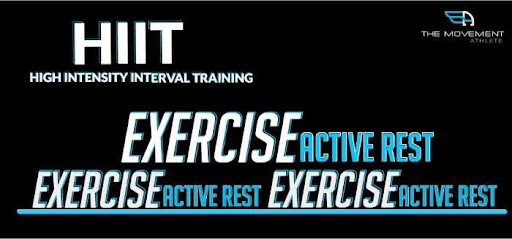
Maintain a high intensity during the exercise, then follow with minimal complete rest or active rest period.
The idea of active rest is to maintain the heart rate elevated. The sustained elevation trains the cardiovascular system while also boosting the metabolic process. And the short period allows you to recover before the next cycle of exercise.
Studies show that a 2:1 exercise to rest ration offers an intense workout while delivering superior results. For example, doing 30 seconds of exercise followed by 15 seconds rest.
But you can play with this depending on your current skill level. For example, you can first start off with a 1:1 ratio, meaning 30 seconds of exercise, then 30 seconds rest, or even a 1:2 ratio of 15 seconds of intense exercise followed by 30 seconds rest.
You may sustain this cycle through the duration of the workout OR use rounds.
For example, after 5 minutes of an exercise-rest cycle, you can take a one-minute rest or even longer before doing another round of HIIT.
The ratio and duration can be manipulated as long as you keep the overall workout intensity high.
You should focus more on exercise choice and intensity in keeping your heart level up.
Exercise intensity
Exercise effort should leave you exhausted. That’s why you can make the workout short. Photo from Freepik
So what does “high-intensity” actually mean?
Intensity refers to how hard you push yourself with the exercise.
This means pushing hard with your exercise and maintaining 80% of your maximum heart rate. You can check out heart rate using a heart rate calculator like this one.
But to make it more subjective and straightforward, you can push hard with an exercise, and at the end of the work period, you should find yourself out of breath and struggling to finish a sentence.
Workout Duration
The main advantage is HIIT is the workout duration. Especially that many tend to have a sedentary lifestyle due to time constraints, HIIT offers a great way to sweat out and stay healthy.
How long you do the workout depends on your current skill level. But because of the shortened time and studies on HIIT, many in the fitness industry took HIIT in a different context and made 5-minute workouts that claim to “burn fat” so you can build abs in just a few minutes.
A study has shown that 8 minutes can suffice to improve cardio and performance, but this might not be enough to lose fats (BUT then again, nutrition plays a significant role).
HIIT was designed to increase athletic performance hence improving cardiovascular state rather than just focusing on weight loss. This means that increasing the duration is your best bet to burn more calories and lose fat.
A study down on male subjects showed that a 20-minute HIIT with a 2:1 work-rest ratio resulted in an average of burning 240-360 calories. But this highly differs from person to person.
Basically, suppose you want to improve your cardiovascular performance. In that case, 8 minutes will suffice, but if you want to burn more calories to help shed fat, extending your HIIT to 20 minutes will be ideal.
HIIT vs Steady-state Training
Since there, there were already many studies supporting the research published by Dr. Tabata.
Research found that HIIT offered a good amount of results for fat loss, and a way to increase the cardiovascular capacity comparable to more traditional, longer steady-state training. However, HIIT provides the advantage of keeping the workout a fraction of the duration of the regular 30 minutes or more of steady-state cardio.
So for more time-constrained individuals, it’s easier to squeeze in a HIIT session rather than pushing steady-state cardio that would require around 30 minutes or more.
HIIT vs Strength training
No room for push-ups here. Do it on a separate workout! Photo from Freepik.
“Fat-burning” HIIT workouts don’t mix well with strength resistance training.
If you want to build strength and muscle, it’s best to do this in a separate session. Don’t do HIIT followed by your strength training, either. This will severely fatigue your body too much and could highly increase the risk of injury in your strength session.
Just think about it, regular resistance training requires at least 60 seconds rest in order for you to recover and begin your sets again. These rest periods have a reason which you can read more about here: How Long Should I Rest in Between Sets
But HIIT requires you only to have short ACTIVE rest, which will not allow you to recover so you can safely and effectively perform the next working sets.
For best results, do strength/muscle-building sessions and HIIT on separate days. The most you can do (if you are advanced enough) is to do strength in the morning then HIIT at night.
For more muscle-building help, you can check out this complete guide: How to Build Muscle with Calisthenics
Keeping it Enjoyable

You can only achieve consistent training if you enjoy it. Photo from Freepik
While getting, seeing, and feeling results is a fantastic way to stay motivated and disciplined in your training, it’s not always the most sustainable approach.
A 2015 study conducted on untrained men showed that a high-intensity protocol usually implemented in HIIT training provides results not different from an internal training with moderate intensity over time.
In addition, the overtly intense training is perceived by many as NOT ENJOYABLE. Hence, this training method might not be sustainable if a full-body HIIT workout is pursued in continuously high intensity.
The better solution for finding effective workouts would be looking for something you find enjoyable.
Although, a HIIT session could still be implemented especially if you can use exercises you enjoy the most and use a more manageable (moderate to high) intensity.
Training Frequency
Given in the name HIIT, the workout will be intense even with a relatively short duration. This means you can do this every day, and you would need time for your body to recover.
Give at least 24 to 48 hours in between your HIIT sessions. In between, you can do mobility workouts, resistance training, or complete rest instead. So that’s 1 to 3 times per week.
Follow these 14 effective tips for maximum recovery from a workout, so you don’t overtrain and drain yourself too soon.
What exercises to avoid
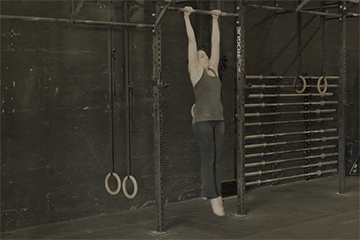
You won’t maximize your gains from pull-ups
Not every exercise can be used for the HIIT protocol because of the short rest periods. Avoid strength exercises, especially with the progression that are challenging for you. Doing as many reps as possible with strengthening exercises defeats the purpose of HIIT since to build strength, you’ll need a low number of reps, but a high level of exercise difficulty.
HIIT exercises aren’t also ideal for building muscle mass, so the basic techniques such as increasing time under tension (“slowly lower” movements) won’t be effective.
The primary purpose of utilizing HIIT is to increase cardiovascular activity, athletic performance, and weight loss. Since the protocol requires doing as many reps as possible while exerting close to exhaustion effort, performing strengthening and muscle-building exercises is dangerous.
Avoid doing push-ups, pull-ups, goblet squat, pistol squats. You will be wasting your time and putting your body at risk, especially if you’re using a challenging progression for you.
Upper body exercises aren’t ideal for raising your heart rate unless you can easily sprint in a handstand!
Exercises to choose from
The best way to approach HIIT is to stick with endurance-based exercises such as the examples below. This way, you can get to maximize the benefits of HIIT while minimizing the risk of injury.
Take note that these are just examples that are usually used in numerous HIIT research, but you can also use different exercises and disciplines and apply the same protocols to achieve the same results.
For less experienced athletes, choosing exercises that are within your capability and have less impact on your joints is your best bet.
Burpees
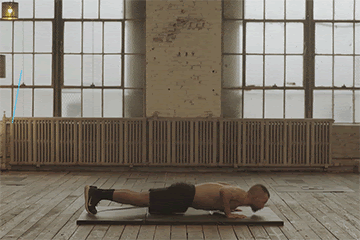
Burpees, also known as a squat thrust, is a fun and effective exercise for HIIT if you have the necessary upper body strength for the exercise.
However, the proper burpee form requires a push-up position before moving into a jump squat. So make sure you already have mastered the push-ups and squats before doing this exercise.
Lack of coordination, proper form awareness, and strength can be dangerous and can lead to injury.
How to perform:
- From standing, move into a partial squat position to prepare a squat jump.
- Jump upward while lifting your arms overhead to generate additional momentum.
- As you catch your land at the bottom of the squat, place your arms extended on the ground.
- Push your legs straight outwards to get into a high plank position.
- Lower down to perform one push-up.
- Explosively, go back up into the high plank position.
- Hop both the legs back close to your hand to reach the bottom squat position.
- Then repeat the jump squat.
- Repeat the jump squat into push-up sequence.
Squat jumps
You can make slight form changes as long as your mobility can handle it and are comfortable with the positions.
Squat jumps are a commonly used exercise in HIIT protocols, but it does require a certain level of physical fitness.
Obviously, mastery of the regular squat is a must to safely execute the exercise, but you can regress it by squatting less deep, meaning knees slightly bent compared to going all the way down. Also, keep your head looking straight ahead and your upper torso upright.
You can also place your feet hip-width apart or shoulder-width apart, depending on the comfortability of the starting position. Remember, we all have different bodies, so this minor form change can depend on person to person.
How to perform:
- Begin in a standing position with feet shoulder-width apart and in the body in good posture.
- Bend your knees and let the hips drop backward to simulate a squat. Raise your arms shoulder level.
- Explosively jump upwards and swing your arms upwards to generate momentum.
- Catch the jump by continuing into a squat.
- Repeat for reps.
Jump rope
Since the pandemic, jump rope has been more popular than ever, especially for those who are looking into their first exercise. Easy, enjoyable, and there’s plenty of variation to play with. It’s also accessible and can be done in a limited space.
There are plenty of techniques you can go about with jump rope for form, so there’s not really a proper form that you need to follow. You can do it by alternating your feet, using both legs to jump, or you can even go fancy with various foot works. Stay at the balls of your feet and keep your movement light.
Another variation to making it difficult is by using a weighted jump rope.
For beginners, you can follow the simple instructions below.
How to perform:
- Hold the rope while keeping your hands at hip height. Feet hip-width apart.
- Bend your knees to prepare for the jump and rotate your wrists to move the rope.
- Jump with both feet at the same time while keeping a good posture. Maintain the knees bent to absorb impact from the jump.
- Repeat the motion until the time.
Mountain climbers
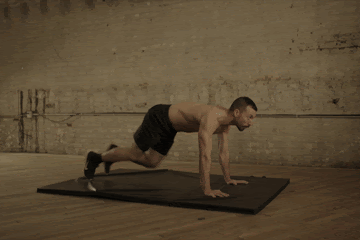
Mountain climber is excellent at keeping your heart rate up while building endurance on your arms and core. Since you will be in the high plank position, you will need to keep the core tight to maintain the position. It’s a whole-body exercise that will “burn” body fat while building a solid core at the same time.
How to perform:
- The high plank position is your starting position with arms shoulder-width apart and straight.
- Move your right knee towards your chest.
- As you move your right knee back to the starting position, simultaneously switch the opposite knee towards your chest.
- Keep the alternating movement while maintaining a high plank position.
- Repeat for reps.
Jump lunges
This exercise is quite similar to squat jumps, but instead of using two legs at the same focus, lunges put more focus on one leg at a time for a more intense burn.
So similar to squats, regular lunges should already be comfortable for you because the demand for the exercise might be too high your body is not yet prepared.
How to perform:
- Begin in a standing position with good posture with spine straight. Legs shoulder-width apart. Hands comfortably resting on your waist. Shoulders relaxed.
- Step your right foot forward far enough to perform a lunge. Keep your left foot stable, but the most weight should be on the right foot that’s flat on the floor.
- Jump upwards in a straight line by pushing through explosively with both legs.
- While in the air, immediately switch leg positions so that when you land on the lunge position with one leg forward, your left foot is in front and your right foot is at the back.
- Keep the knees bent and absorb the landing.
- One rep is one cycle of alternating the two. Repeat for the duration.
High knees
High knees are simple yet may feel excruciatingly brutal when done in a HIIT protocol. To perform high knees effectively, maintain the height of your knees is going. It sounds easy, but when fatigue sets in, it will feel like hell.
High knees are perfect for HIIT since you can also lower the height if your fitness level doesn’t let you sustain the high intensity for now.
How to perform:
- Begin in a standing position with arms in front of you around hip level to gauge the height of your knees. Feet hip-width apart.
- Lift your right leg upward so that your right knee touches your hand.
- Then explosively switch legs so that your left leg moves and your left knee touches your hand.
- After one cycle of alternating is one rep, repeat the movement throughout the duration.
What exercises to avoid
Active rest exercises are even low-impact compared to the exercises above and much lower difficulty.
It can be easy (you might not feel that it’s so easy once you get started with HIIT) as jogging in place, brisk walking around, or more intense such as the exercises below.
Jog in place
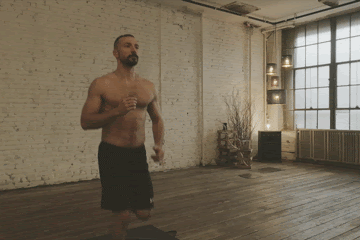
Keep it at a steady pace. Make it light enough so you can catch your breath before the next exercise cycle. Then, you can go slower if you need to and don’t need to lift your legs too high.
How to perform:
- Begin in a standing position with good posture and just look straight ahead.
- Lift your left arm and right leg at the same time.
- Immediately switch by putting your left arm and right leg down and lifting your left leg and right arm.
- Maintain the rhythm and continue the movement.
Jumping jacks

Who doesn’t know how to do jumping jacks? It’s a gym class classic.
Jumping jacks can also be placed as the main exercise with speed and power; for now, we can keep it light by keeping the “jump” low.
How to perform:
- Stand with good posture as a starting position. Feet hip-width apart.
- Hop upward in a straight line while simultaneously moving arms overhead through the side and your legs extended outward for a wider stance.
- Immediately, jump back into the starting position. That’s one rep.
- Repeat for a period.
20-minute Bodyweight HIIT Workout to Lose Weight and Burn Fat
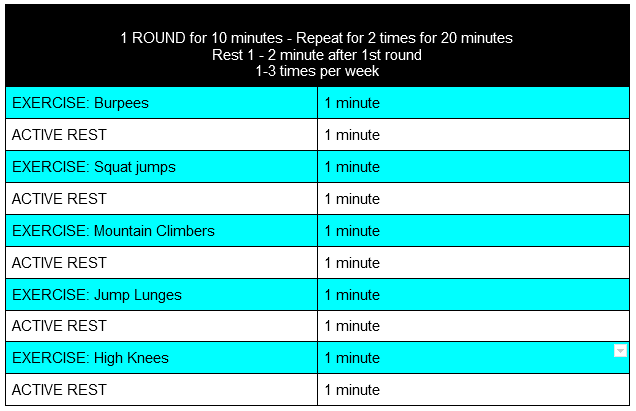
Take note of these key points:
- Do the exercises with proper form
- You can change the exercises
- Choose your active rest from jogging in place, light jumping jacks, or brisk walk
- You can adjust the work-rest ratio
- Do proper warm-up before workout and cool down after
Conclusion
You now have the proper structure to design your own High-Intensity Interval Training program backed up by science.
No B.S.
No pseudo science.
No marketing ploys to get you started burning fat and improving your overall health and performance.
Even though HIIT is a fantastic protocol to implement, it’s just one tool that can help you improve your fitness level. When doing HIIT, it is still vital to implement regular resistance training (let’s go with calisthenics, of course!), proper nutrition, and recovery habits.
HIIT can make you boost your progress, but it’s not the answer for everything.
Since you now have a HIIT program you can tailor, we highly advise partnering it with a personalized calisthenics program to help you improve your strength, mobility, and flexibility.
The first step to personalization is knowing how where you are in your current fitness journey. Begin your personalized training by taking the assessment below.
TAKE THE ASSESSMENT NOW!

